IoT Applications in Agriculture and Environment: A Systematic Review Based on Bibliometric Study in West Africa
Abstract
1. Introduction
2. Related Works
2.1. IoT Applications in Agriculture
2.2. IoT Applications in Environment
3. Materials and Methods
3.1. Materials
3.2. Methods
4. Results
4.1. Quantitative Analysis: Bibliometric Study
4.1.1. Database Main Information
4.1.2. Annual Scientific Production
4.1.3. Most Relevant Sources and Locally Cited Sources
4.1.4. Most Relevant Authors and Most Locally Cited Authors
4.1.5. Most Relevant Affiliations
4.1.6. Most Locally and Globally Cited Papers
4.1.7. Countries’ Production
4.1.8. Countries’ Production over Time
4.1.9. Affiliations’ Production over Time
4.1.10. Country Collaboration Map
4.2. Qualitative Analysis: Relevant Works Review
5. Discussion
5.1. Application Domains
- Monitoring of livestock and fish farming: this involves the monitoring of the environmental parameters (basins, water quality, etc.) of the animals as well as the internal (health) parameters of the animals themselves.
- Monitoring of crops and soil for smart precision agriculture (moisture, humidity, temperature, pest control, etc.).
- Monitoring of meteorological parameters for agriculture.
- Smart irrigation systems.
- Detection of animal intrusion in fields.
- Monitoring of water quality.
- Monitoring of air quality (unwanted gaseous substance emission and particulate matter).
- Monitoring of meteorological parameters such as rainfall, wind speed, sunshine and air humidity.
- Monitoring of solar street lamps.
5.2. Sensor Data Collection
5.3. Challenges
5.4. Opportunities and Future Directions
- Monitoring of waterways, the water levels and the quality to avoid or manage floods during the rainy seasons and safeguard the biodiversity in waterways.
- Accurate forecasting of drought and rainfall due to climate change, to enable making appropriate decisions.
- Collection of temperature data, which is useful to predict periods of peak temperatures currently experienced in West Africa, which are almost unbearable without air conditioning.
- Monitoring or tracking of animals in their natural environment or in the livestock sector using IoT. The animals in the herd may be monitored to observe their behavior, state of health and reactions to potential threat.
- Crop and soil type prediction using emerging technologies to identify the compatibility between crops and soils and the season suitable for the crop production. In other words, it means the use of digital technologies to make the variable-rate technology (VRT) more effective in these countries. The variable-rate technology enables growers to vary the rate of crop inputs such as fertilizer, soil amendments, irrigation and agricultural chemicals.
- Greenhouse farming using emerging technology such as IoT, Artificial Intelligence, robotics and data analytics. Agricultural greenhouses offer an ideal solution for improving crop productivity, especially in Africa, where climatic conditions can be extreme. Its main advantages are protection against pests and diseases, optimized use of water resources and year-round production.
- Improvement of the fishing system using precision fishing for small- and large-scale fishing. Precision fishing consists of the use of advanced tools and technologies to optimize fishing operations and management. Fishermen can optimize fish production while fishing in a more sustainable way.
- Development of rice-fish farming systems to jointly improve the rice and fish production. It is based on a mutually beneficial relationship between rice and fish in the same agroecosystem, most commonly with freshwater fish.
6. Conclusions
Author Contributions
Funding
Data Availability Statement
Conflicts of Interest
References
- Oruma, S.O.; Misra, S.; Fernez-Sanz, L. Agriculture 4.0: An implementation framework for food security attainment in Nigeria’s post-Covid-19 era. IEEE Access 2021, 9, 83592–83627. [Google Scholar] [CrossRef]
- World Bank Group. A Roadmap for Building the Digital Future of Food and Agriculture. Available online: https://www.worldbank.org/en/news/feature/2021/03/16/a-roadmap-for-building-the-digital-future-of-food-and-agriculture (accessed on 2 October 2024).
- United Nation. Department of Economic and Social Affairs Statistics. Available online: https://unstats.un.org/sdgs/report/2022/Goal-11/ (accessed on 2 October 2024).
- FAO; IFAD; UNICEF; WFP; WHO. The State of Food Security and Nutrition in the World. Urbanization, Agrifood Systems Transformation and Healthy Diets Across the Rural–Urban Continuum; FAO: Rome, Italy, 2023. [Google Scholar] [CrossRef]
- Toromade, A.S.; Soyombo, D.A.; Kupa, E.; Ijomah, T.I. Reviewing the impact of climate change on global food security: Challenges and solutions. Int. J. Appl. Res. Soc. Sci. 2024, 6, 1403–1416. [Google Scholar] [CrossRef]
- Cellier, P.; Génermont, S.; Pierart, A.; Agasse, S.; Drouet, J.L.; Edouard, N.; Roussel, I. Reducing the Impacts of Agriculture on Air Quality. In Agriculture and Air Quality: Investigating, Assessing and Managing; Springer: Dordrecht, The Netherlands, 2020; pp. 245–282. [Google Scholar]
- Ogwu, M.C.; Lori, T.; Aliu, O.O.; Febnteh, E.B.; Izah, S.C.; Abdelkhalek, S.T. Agricultural Air Pollution: Impacts, Sources, and Mitigation Strategies. In Air Pollutants in the Context of One Health: Fundamentals, Sources, and Impacts; Springer: Cham, Switzerlands, 2024; Volume 9, pp. 395–423. [Google Scholar]
- World Health Organization (WHO). Overview of Methods to Assess Population Exposure to Ambient Air Pollution; World Health Organization: Geneva, Switzerlands, 2023. [Google Scholar]
- World Health Organization. Available online: https://www.who.int/health-topics/environmental-health (accessed on 11 October 2023).
- Costa, F.; Frecassetti, S.; Rossini, M.; Portioli-Staudacher, A. Industry 4.0 digital technologies enhancing sustainability: Applications and barriers from the agricultural industry in an emerging economy. J. Clean. Prod. 2023, 408, 137208. [Google Scholar] [CrossRef]
- Duguma, A.L.; Bai, X. Contribution of Internet of Things (IoT) in improving agricultural systems. Int. J. Environ. Sci. Technol. 2024, 21, 2195–2208. [Google Scholar] [CrossRef]
- International Business Machines. Available online: https://www.ibm.com/topics/internet-of-things (accessed on 11 November 2023).
- Lynn, T.; Mooney, J.G.; Lee, B.; Endo, P.T. The Cloud-to-Thing Continuum: Opportunities and Challenges in Cloud, Fog and Edge Computing; Open Access; Springer Nature: Cham, Switzerlands, 2020; p. 161. [Google Scholar]
- Mohd, J.; Abid, H.; Ravi, P.S.; Rajiv, S. Enhancing smart farming through the applications of Agriculture 4.0 technologies. Int. J. Intell. Netw. 2022, 3, 150–164. [Google Scholar]
- Alahmad, T.; Neményi, M.; Nyéki, A. Applying IoT sensors and big data to improve precision crop production: A review. Agronomy 2023, 13, 2603. [Google Scholar] [CrossRef]
- Abdulai, A.R.; Gibson, R.; Fraser, E.D. Beyond transformations: Zooming in on agricultural digitalization and the changing social practices of rural farming in Northern Ghana, West Africa. J. Rural. Stud. 2023, 100, 103019. [Google Scholar] [CrossRef]
- Choruma, D.J.; Dirwai, T.L.; Mutenje, M.; Mustafa, M.; Chimonyo, V.G.P.; Jacobs-Mata, I.; Mabhaudhi, T. Digitalisation in agriculture: A scoping review of technologies in practice, challenges, and opportunities for smallholder farmers in sub-Saharan Africa. J. Agric. Food Res. 2024, 18, 101286. [Google Scholar] [CrossRef]
- Abdollahi, A.; Rejeb, K.; Rejeb, A.; Mostafa, M.M.; Zailani, S. Wireless sensor networks in agriculture: Insights from bibliometric analysis. Sustainability 2021, 13, 112011. [Google Scholar] [CrossRef]
- Jorge, E.N.L.F.; Thode Filho, S.; de Farias, C.M. Smart agricultural environments using knowledge representation with the use of IoT: Bibliometric Review. Braz. J. Exp. Des. Data Anal. Inferent. Stat. 2021, 1, 172–185. [Google Scholar]
- Shete, R.; Bongale, A.M.; Bongale, A. Internet of Things Based Messaging Protocols for Aquaculture Applications—A Bibliometric Analysis and Review; Library Philosophy and Practice (e-journal): Lincoln, NE, USA, 2021. [Google Scholar]
- Degila, J.; Tognisse, I.S.; Honfoga, A.-C.; Houetohossou, S.C.A.; Sodedji, F.A.K.; Avakoudjo, H.G.G.; Tahi, S.P.G.; Assogbadjo, A.E. A Survey on Digital Agriculture in Five West African Countries. Agriculture 2023, 13, 1067. [Google Scholar] [CrossRef]
- Quansah, J.E.; Rochon, G.L.; Quagrainie, K.K.; Amisah, S.; Muchiri, M.; Ngugi, C. Remote sensing applications for sustainable aquaculture in Africa. In Proceedings of the 2007 IEEE International Geoscience and Remote Sensing Symposium, Barcelona, Spain, 23–28 July 2007; pp. 1255–1259. [Google Scholar] [CrossRef]
- Saini, J.; Dutta, M.; Marques, G. Indoor air quality monitoring systems based on internet of things: A systematic review. Int. J. Environ. Res. Public Health 2020, 17, 4942. [Google Scholar] [CrossRef] [PubMed]
- Broday, E.E.; Gameiro da Silva, M.C. The role of internet of things (IoT) in the assessment and communication of indoor environmental quality (IEQ) in buildings: A review. Smart Sustain. Built Environ. 2023, 12, 584–606. [Google Scholar] [CrossRef]
- RStudio Integrated Development Environment (IDE). Available online: https://www.rstudio.com/categories/rstudio-ide/ (accessed on 11 July 2023).
- Bibliometrix Package-RDocumentation. Available online: https://www.rdocumentation.org/packages/bibliometrix/versions/4.1.4 (accessed on 11 July 2023).
- Hauck, C.; Barthlott, C.; Krauss, L.; Kalthoff, N. Soil moisture variability and its influence on convective precipitation over complex terrain. Q. J. R. Meteorol. Soc. 2011, 137, 42–56. [Google Scholar] [CrossRef]
- Mbonu, E.S.; Kennedy, C.O.; Godwin, O.U.; Chinwe, G.E. E-MART: A novel Smart Home Governance System for a densely populated power challenged environment. In Proceedings of the 2013 IEEE International Conference on Emerging & Sustainable Technologies for Power & ICT in a Developing Society (NIGERCON), Owerri, Nigeria, 14–16 November 2013; pp. 100–105. [Google Scholar] [CrossRef]
- Kama, A.; Diallo, M.; Drame, M.S.; Ndiaye, M.L.; Ndiaye, A.; Ndiaye, P.A. Monitoring the Performance of Solar Street Lights in Sahelian Environment: Case Study of Senegal. In Proceedings of the 2017 10th International Conference on Developments in eSystems Engineering (DeSE), Paris, France, 14–16 June 2017; pp. 56–61. [Google Scholar] [CrossRef]
- Elijah, O.; Orikumhi, I.; Rahman, T.A.; Babale, S.A.; Orakwue, S.I. Enabling smart agriculture in Nigeria: Application of IoT and data analytics. In Proceedings of the 2017 IEEE 3rd International Conference on Electro-Technology for National Development (NIGERCON), Owerri, Nigeria, 7–10 November 2017; pp. 762–766. [Google Scholar] [CrossRef]
- Zougmore, T.-W.; Malo, S.; Kagembega, F.; Togueyini, A. Low cost IoT solutions for agricultures fish farmers in Afirca: A case study from Burkina Faso. In Proceedings of the 2018 1st International Conference on Smart Cities and Communities (SCCIC), Ouagadougou, Burkina Faso, 24–26 July 2018; pp. 1–7. [Google Scholar] [CrossRef]
- Dupont, C.; Wussah, A.; Malo, S.; Thiare, O.; Niass, F.; Pham, C.; Dupont, S.; Le Gall, F.; Cousin, P. Low-Cost IoT Solutions for Fish Farmers in Africa. In Proceedings of the 2018 IST-Africa Week Conference (IST-Africa), Gaborone, Botswana, 9–11 May 2018; pp. 1–8. [Google Scholar]
- Seye, M.R.; Ngom, B.; Diallo, M.; Gueye, B. Work in Progress: A low cost geographical localization system for a more secure coastal artisanal fishery in Senegal. In Proceedings of the 2019 International Conference on Information and Communication Technologies for Disaster Management (ICT-DM), Paris, France, 18–20 December 2019; pp. 1–4. [Google Scholar] [CrossRef]
- Seye, M.R.; Diallo, M.; Gueye, B.; Cambier, C. COWShED: Communication within white spots for breeders. In Proceedings of the 22nd Conference on Innovation in Clouds, Internet and Networks and Workshops (ICIN) 2019, Paris, France, 19–21 February 2019; pp. 236–238. [Google Scholar]
- Omokungbe, O.R.; Fawole, O.G.A.; Owoade, O.K.; Popoola, O.A.M.; Jones, R.L.; Olise, F.S.; Ayoola, M.A.; Abiodun, P.O.; Toyeje, A.B.; Olufemi, A.P.; et al. Analysis of the variability of airborne particulate matter with prevailing meteorological conditions across a semi-urban environment using a network of low-cost air quality sensors. Heliyon 2020, 6, e04207. [Google Scholar] [CrossRef]
- Abulude, F.O.; Damodharan, U.; Acha, S.; Adamu, A.; Arifalo, K.M. Preliminary assessment of air pollution quality levels of Lagos, Nigeria. Aerosol Sci. Eng. 2021, 5, 275–284. [Google Scholar] [CrossRef]
- McFarlane, C.; Raheja, G.; Malings, C.; Appoh, E.K.E.; Hughes, A.F.; Westervelt, D.M. Application of Gaussian mixture regression for the correction of low cost PM2. 5 monitoring data in Accra, Ghana. ACS Earth Space Chem. 2021, 5, 2268–2279. [Google Scholar] [CrossRef]
- Kosisochukwu, P.N.; Mbadiwe, S.B.; Oladayo, O.O.; Doris, A.U. The Computer Farmer Concept: Human-cyberphysical Systems for Monitoring and Improving Agricultural Productivity in Nigeria. In Proceedings of the EEE Nigeria 4th International Conference on Disruptive Technologies for Sustainable Development (NIGERCON), Lagos, Nigeria, 5–7 April 2022. [Google Scholar]
- Babatunde, A.; Gabriel, O.; Olatunji, J.; Ruaraidh, D.; Abdoul, R.O.; Bakary, D.; Mbatchou, N.; Chizalu, N.; Chuka, A.; Diana, M.; et al. Longitudinal Ambient PM2.5 Measurement at Fifteen Locations in Eight Sub-Saharan African Countries Using Low-Cost Sensors. Atmosphere 2022, 13, 1593. [Google Scholar]
- Sidibe, A.; Sakamoto, Y.; Murano, K.; Koita, O.A.; Traore, I.; Dansoko, Y.; Kajii, Y. Personal Exposure to Fine Particles (PM2.5) in Northwest Africa: Case of the Urban City of Bamako in Mali. Int. J. Environ. Res. Public Health 2022, 19, 611. [Google Scholar] [CrossRef]
- Pelagie, H.; Romaric, S.; Gilles, D.; Julien, K. Smart Monitoring System using Internet of Things: Application for Agricultural Management in Benin. Int. J. Adv. Comput. Sci. Appl. 2022, 13. [Google Scholar] [CrossRef]
- Chukwu, T.M.; Morse, S.; Murphy, R.J. Spatial Analysis of Air Quality Assessment in Two Cities in Nigeria: A Comparison of Perceptions with Instrument-Based Methods. Sustainability 2022, 14, 5403. [Google Scholar] [CrossRef]
- Raheja, G.; Sabi, K.; Sonla, H.; Gbedjangni, E.K.; McFarlane, C.M.; Hodoli, C.G.; Westervelt, D.M. A Network of Field-Calibrated Low-Cost Sensor Measurements of PM2.5 in Lomé, Togo, Over One to Two Years. Acs Earth Space Chem. 2022, 6, 1011–1021. [Google Scholar] [CrossRef] [PubMed]
- Hodoli, C.G.; Coulon, F.; Mead, M.I. Source identification with high-temporal resolution data from low-cost sensors using bivariate polar plots in urban areas of Ghana. Environ. Pollut. 2023, 317, 120448, ISSN 0269-7491. [Google Scholar] [CrossRef] [PubMed]
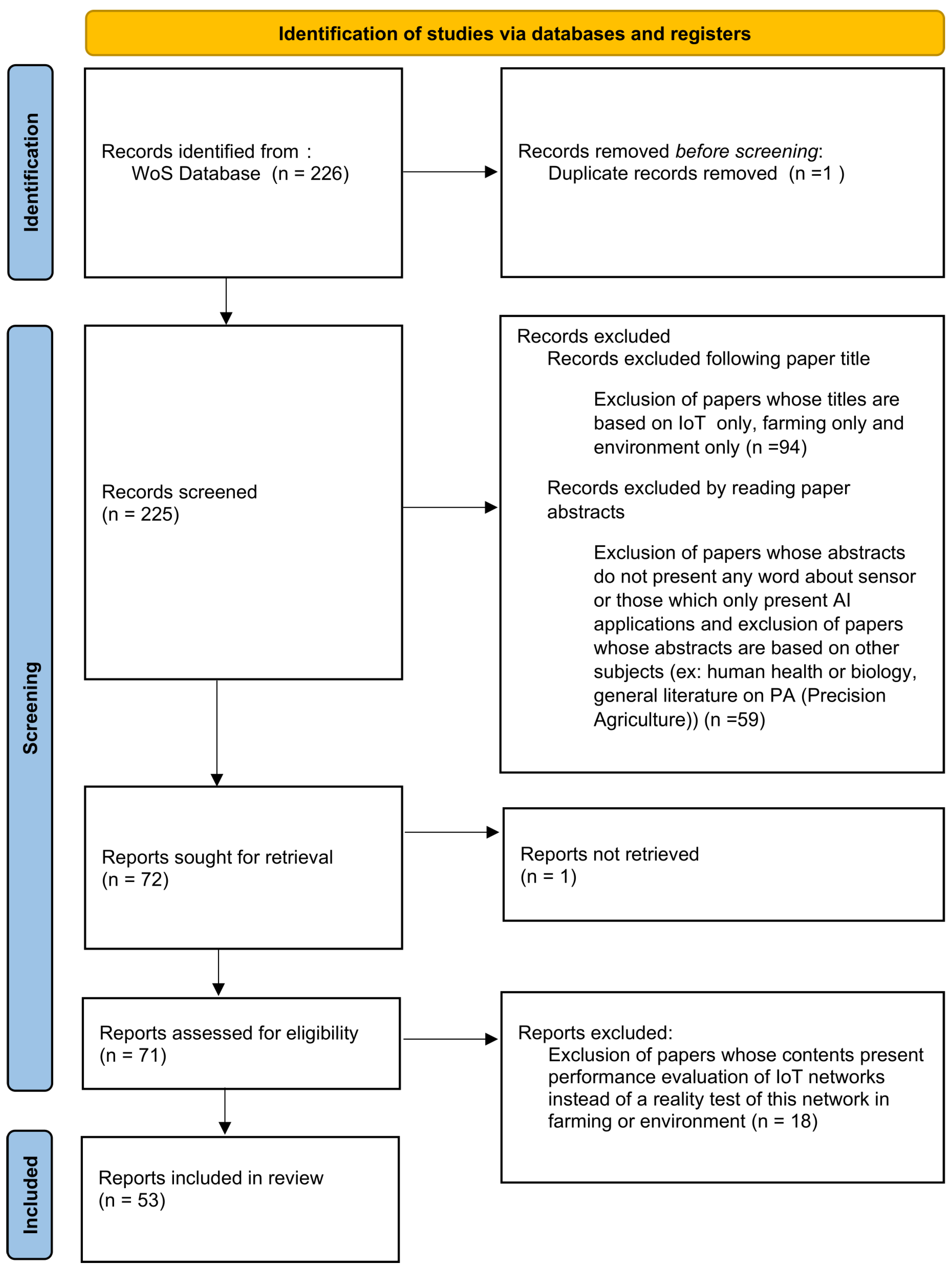

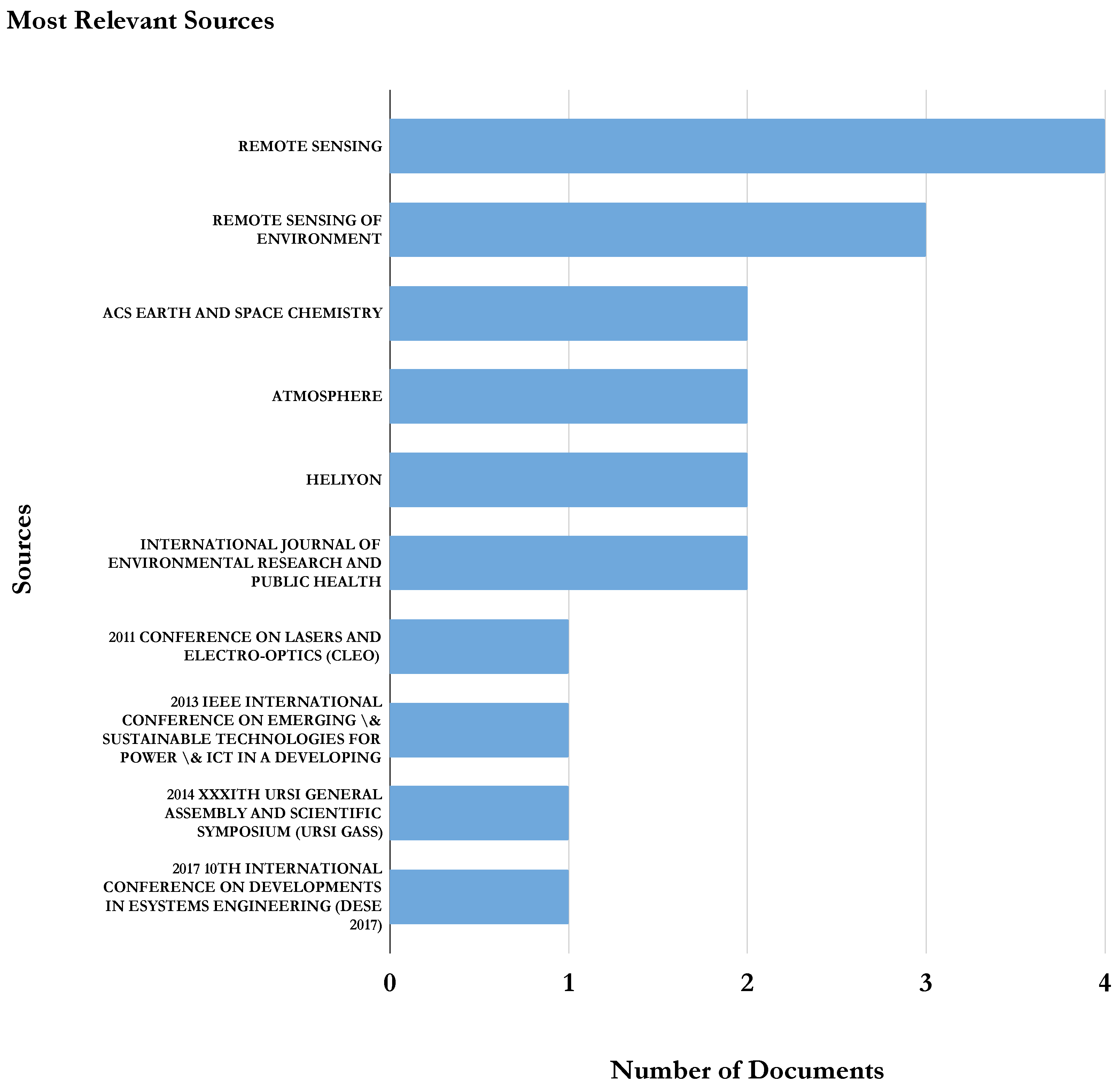
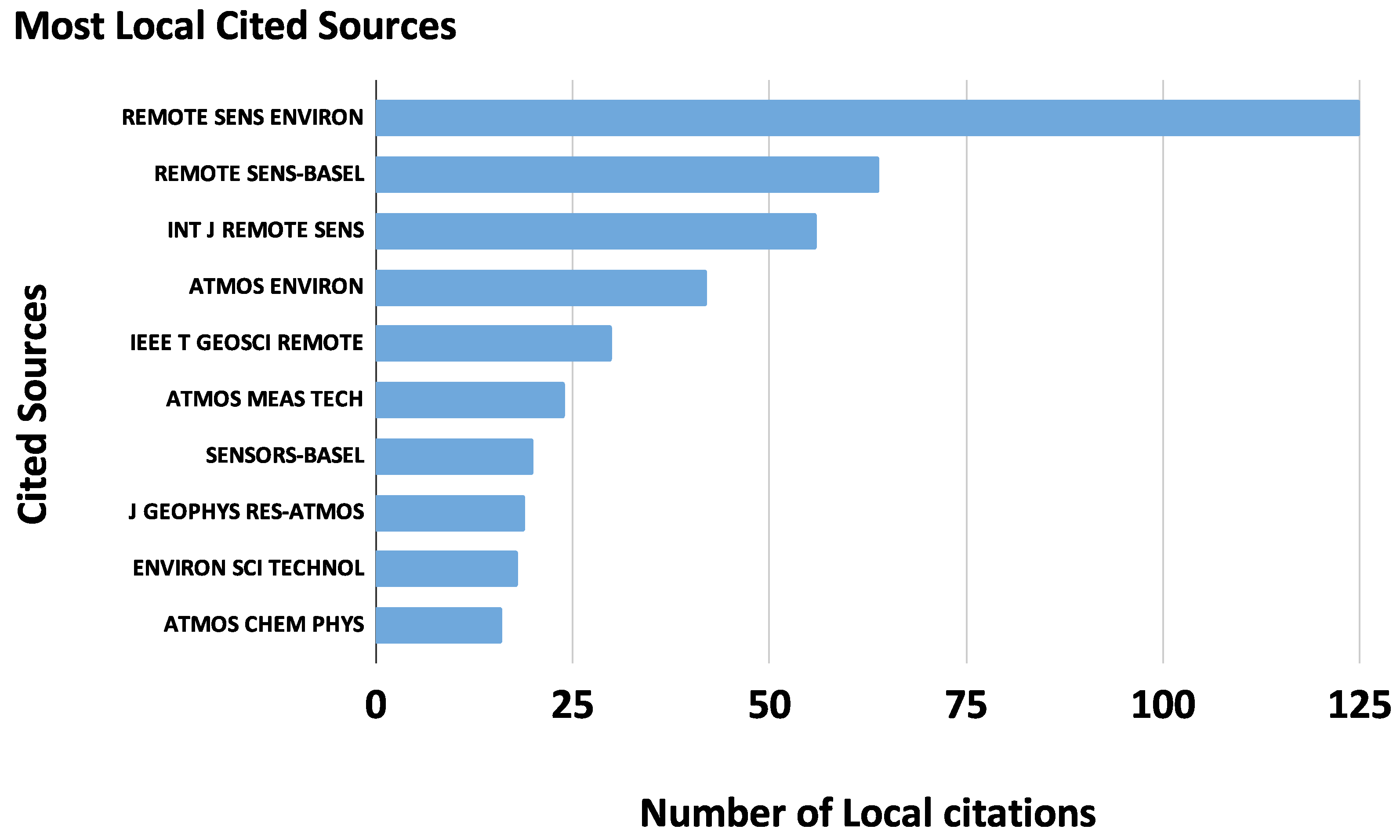
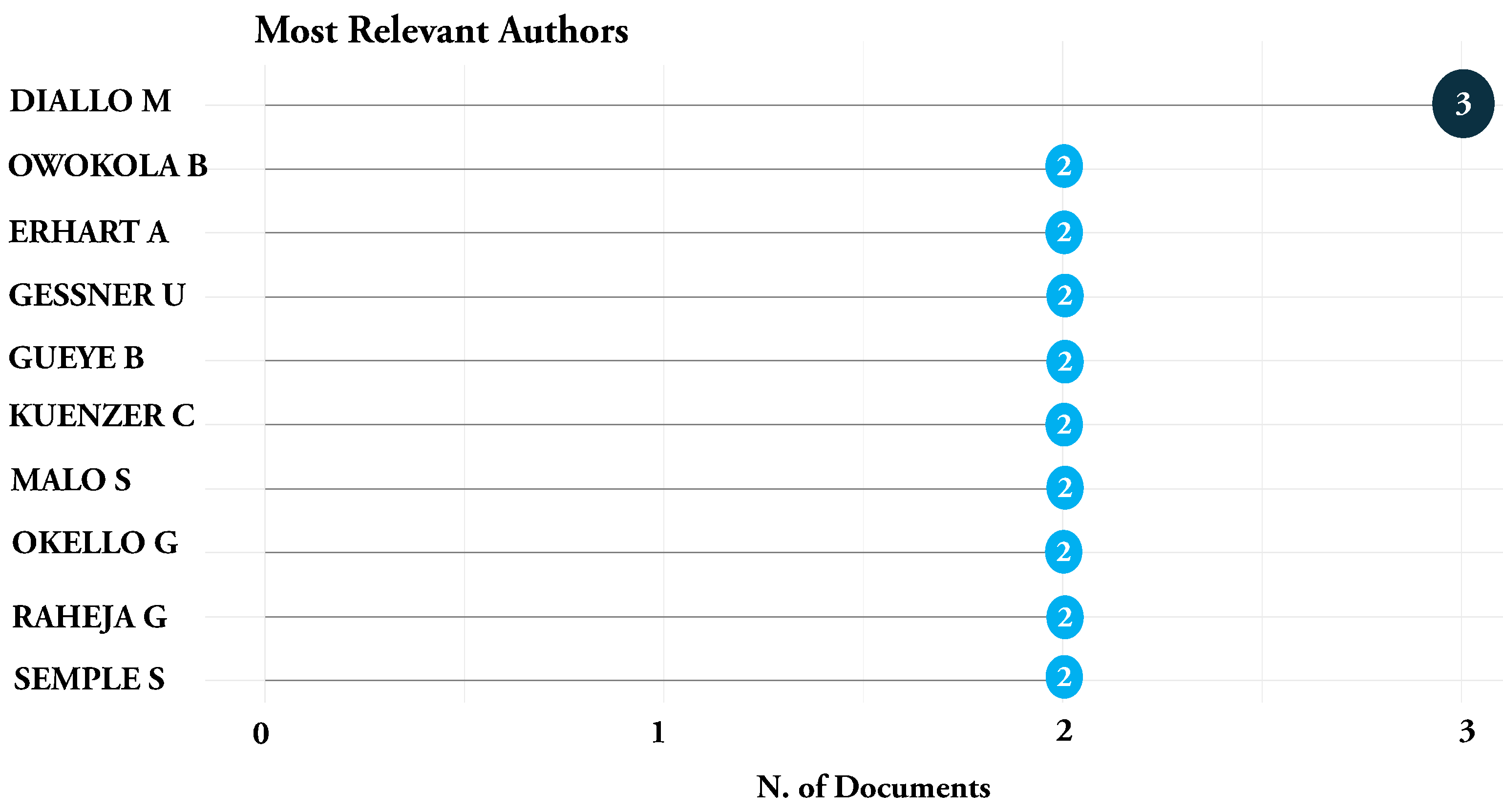
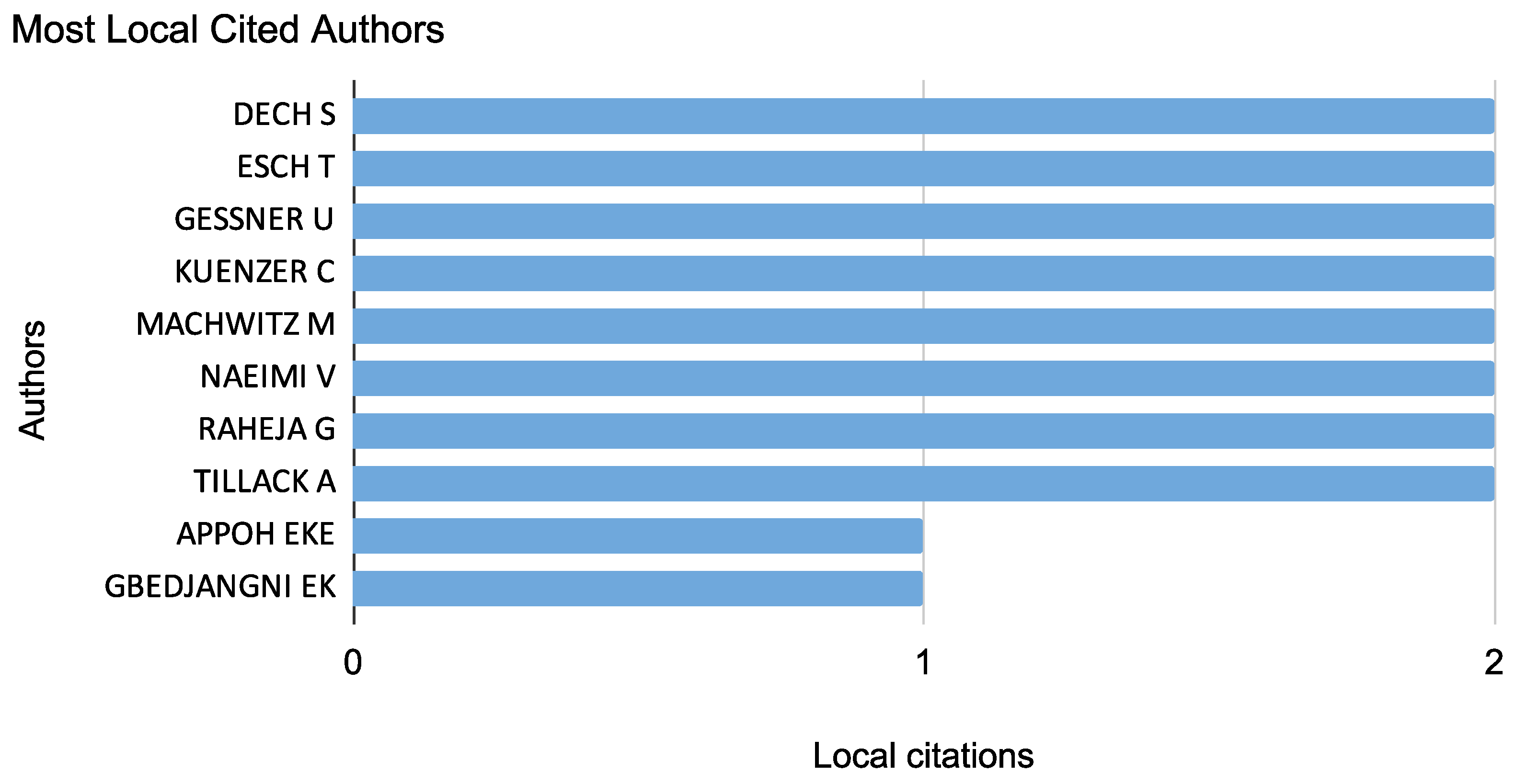

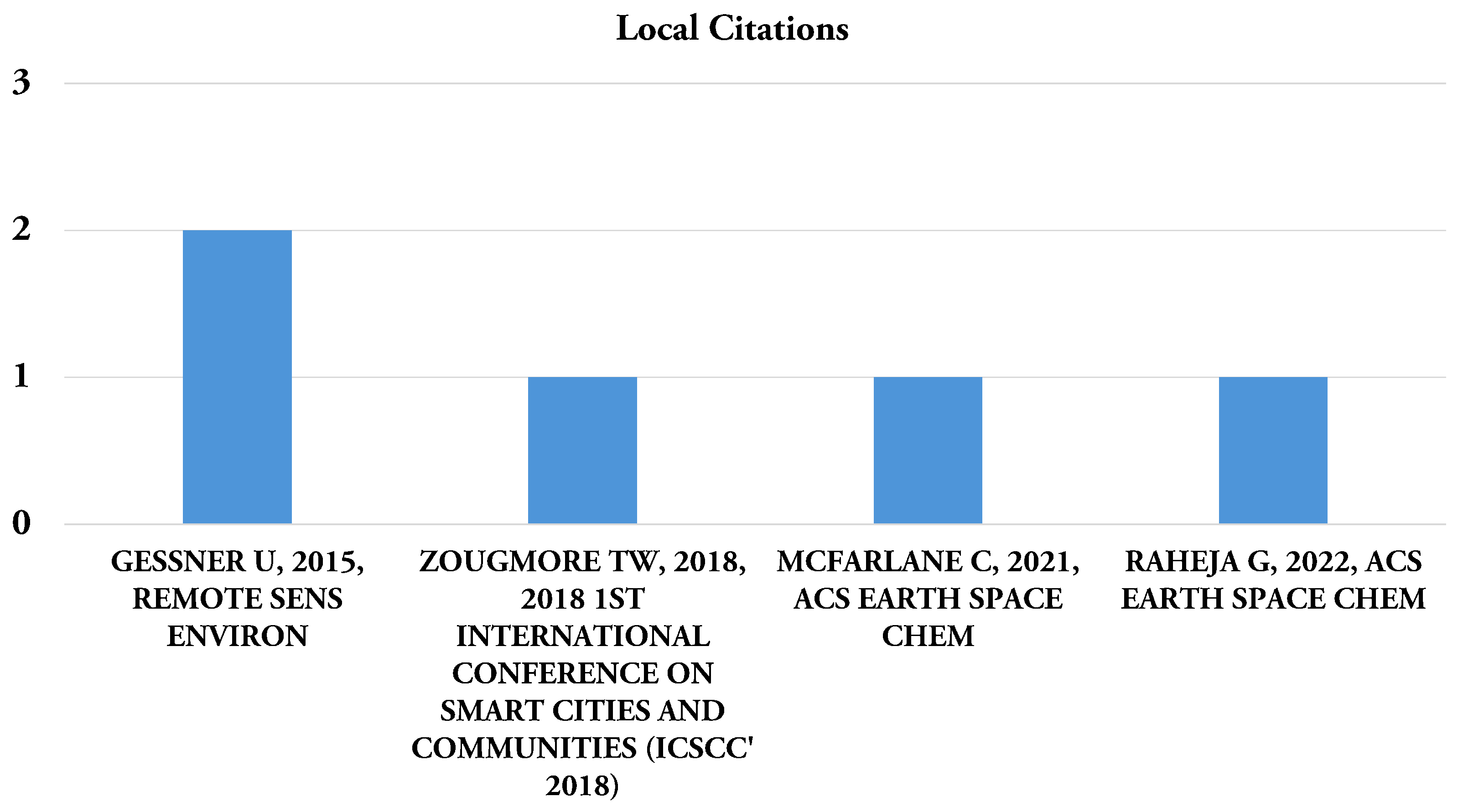

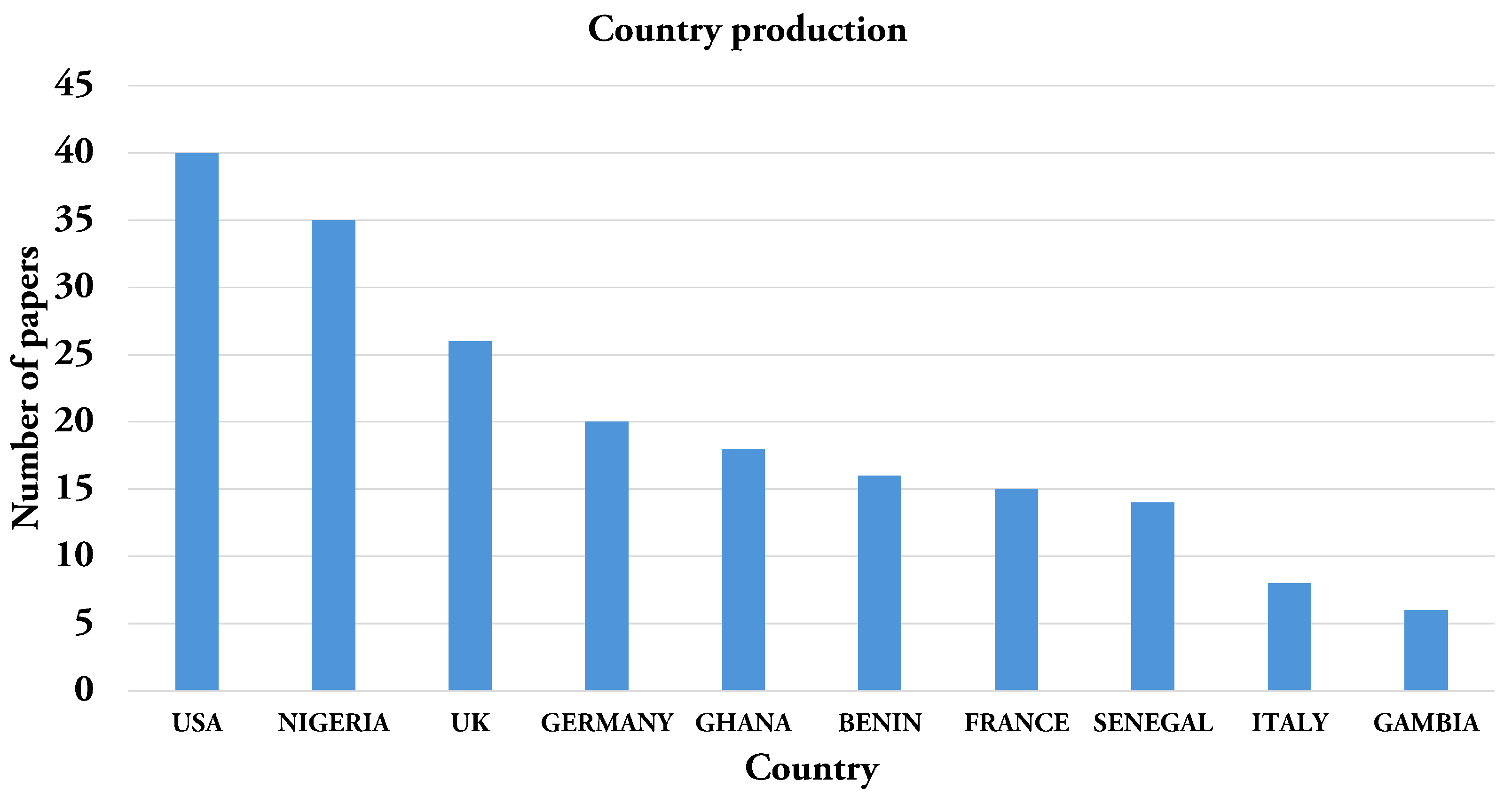

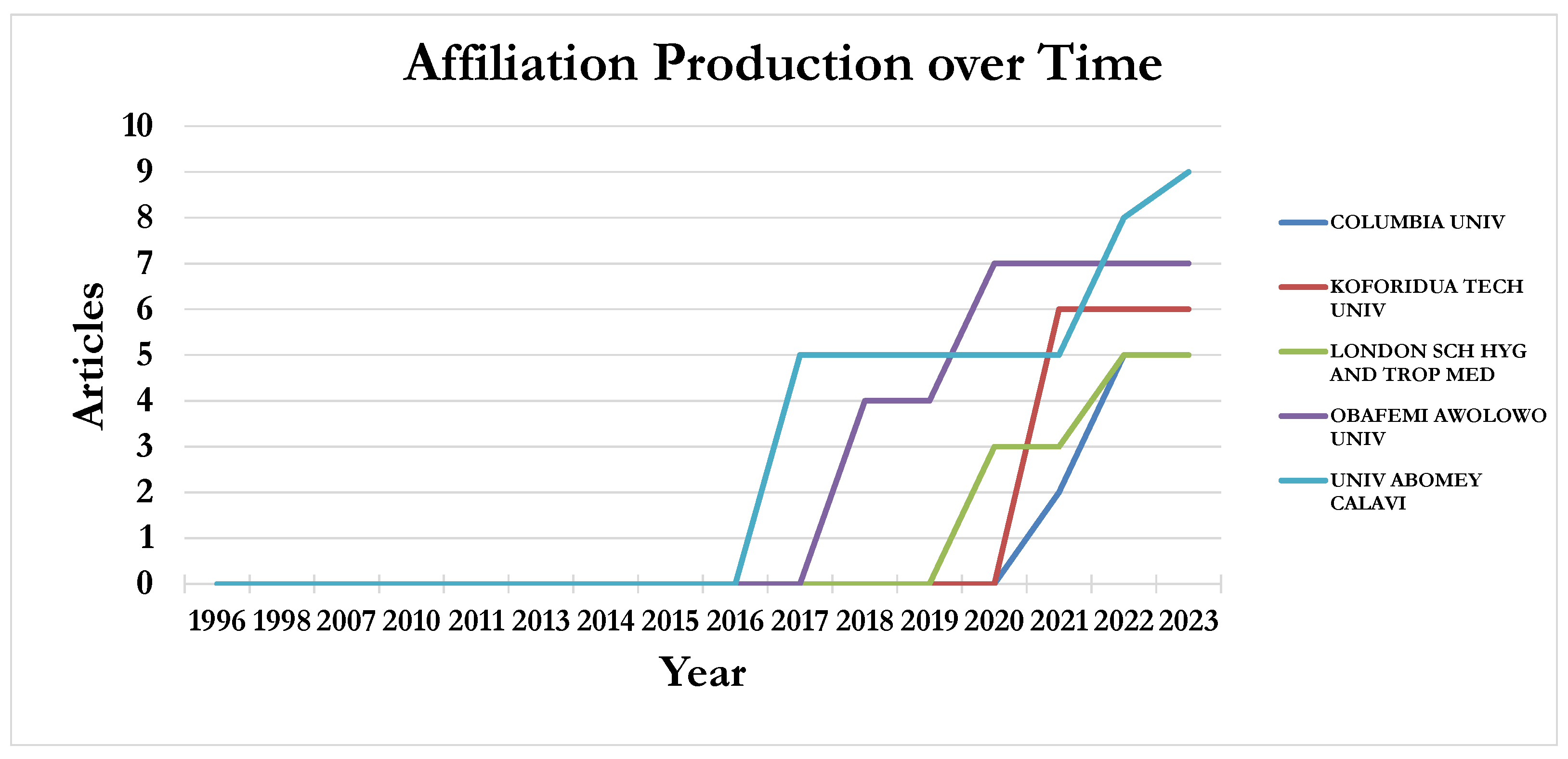

| Authors | Full Names | Affiliation | City | Country |
|---|---|---|---|---|
| Diallo M | Diallo, Moussa | Cheikh Anta Diop University | Dakar | Senegal |
| Awokola B | Awokola Babatunde | Liverp Sch of Trop Med | Liverpool | UK |
| Erhart A | Erhart, Annette | Lond Sch of Hyg and Trop Med | London | UK |
| Gessner U | Gessner, Ursula | German Aerospace Center | Wessling | Germany |
| Gueye B | Gueye, Bamba | Cheikh Anta Diop University | Dakar | Senegal |
| Kuenzer C | Kuenzer, Claudia | German Aerospace Center | Wessling | Germany |
| Malo S | Malo, Sadouanouan | Nazi BONI University | Bobo Dioulasso | Burkina Faso |
| Okello G | Okello, Gabriel | University of Cambridge | Cambridge | UK |
| Raheja G | Raheja, Garima | Columbia University | New York | USA |
| Semple S | Semple, Sean | University of Stirling | Scotland | UK |
| Authors | Full Names | Affiliation | City | Countries |
|---|---|---|---|---|
| DECH S | Dech, Stefan | German Aerospace Center | Wessling | Germany |
| ESCH T | Esch, Thomas | German Aerospace Center | Wessling | Germany |
| GESSNER U | Gessner, Ursula | German Aerospace Center | Wessling | Germany |
| KUENZER C | Kuenzer, Claudia | German Aerospace Center | Wessling | Germany |
| Machwitz M | Machwitz, Miriam | Lux. Inst. of Sci. and Tech. | Belvaux | Luxembourg |
| Naeimi V | Naeimi, Vahid | Vien. Univ. of Tech. | Vienna | Austria |
| Raheja G | Raheja, Garima | Columbia University | New York | USA |
| Tillack A | Tillack, Adina | German Aerospace Center | Wessling | Germany |
| Appoh Eke | Appoh, Eke | Ghana Env. Prot. Agen. | Accra | Ghana |
| Gbedjangni EK | Gbedjangni, Eric | University of Lome | Lome | Togo |
| Ref. | Authors (Year) | Title | Domain | Application | Objectives | Outcomes |
|---|---|---|---|---|---|---|
| [22] | J. Quansah et al. (2007) | Remote Sensing Applications for Sustainable Aquaculture in Africa | Agriculture | Fish farming | Review on remote sensing applications for aquaculture in Africa for tilapia and for catfish. | Evaluation of a multi-sensor remote sensing deployment to support sustainable fish farming in Ghana and Kenya. |
| [27] | C. Hauck et al. (2011) | Soil moisture variability and its influence on convective precipitation over complex terrain | Agriculture | Soil moisture | Analyse the discrepancies between two types of soil moisture from observation and modelling to highlight their impacts on convective precipitation forecasts. | This work shows that convection parameters are linked to the soil moisture. |
| [28] | Mbonu E. S. et al. (2013) | E-MART: A Novel Smart Home Governance System for a Densely Populated Power Challenged Environment | Environment | Unwanted gaseous substances such as Carbon Monoxide | Solution for dealing with recurring CO poison incidents. | The proposed solution can solve the problem of poison intoxication from carbon monoxide resulting from fuel generators. |
| [29] | Abdoulaye Kama et al. (2017) | Monitoring the Performance of Solar Street Lights in Sahelian Environment: Case Study of Senegal | Environment | Solar street light | Evaluation of the influence of dust deposits on the degradation of solar street light modules in Senegal. | Better planning of street light solar maintenance. |
| [30] | O. Elijah et al. (2017) | Enabling Smart Agriculture in Nigeria: Application of IoT and Data Analytics | Agriculture | Smart farming | Use of IoT and data analytics to solve food availability issues. | Proposal of a data center for agricultural data collection such a rainfall, water availability, soil fertility, etc. Proposition of Youth Empowerment Schemes to reinforce youth skills in data analytics and embedded system programming. |
| [31] | Téeg-Wendé Z. et al. (2018) | Low cost IoT solutions for agriculture fish farmers in Africa: a case study from Burkina Faso | Agriculture and environment | Fish farming, soil moisture and meteorological parameters | Prototype and deploy a low-cost and low-energy IoT system that monitors water quality (for fishery), soil parameters (for agriculture) and environment parameters to help farmers and fish farmers increase the yield of fishing and agriculture. | A system composed of low-cost sensors (powered with batteries and solar panels), long-range communication modules (LoRa and GSM modules) and a specially designed cloud platform (for data analysis and visualization) is developed and deployed. |
| [32] | Charlotte D. et al. (2018) | Low-Cost IoT Solutions for Fish Farmers in Africa | Agriculture and environment | Fish farming | The solution proposed will allow us to improve fish farming business in Africa by using a water quality monitoring system. | The collected measurements help to point out some recurrent issues and to give recommendations for better water quality and increased fish production yield. |
| [33] | M. R. Seye et al. (2019) | Work in Progress: A low cost geographical localization system for a more secure coastal artisanal fishery in Senegal | Agriculture | Fish farming | This study proposes a communication system for fishermen to be informed about dugout canoes’ damages and allows for information sharing between fishermen. | The communication system is enabled by long-range technology. Several performance evaluations were performed and a received signal strength of m over a 22 km distance was measured. |
| [34] | Seye, M. R. et al. (2019) | COWShED: Communication within white spots for breeders | Agriculture | Livestock | Ensure communication between herders, in a noncovered zone, based on LoRa transmission. Provide a cheaper solution than satellite communications, which are very expensive for rural populations. | The proposition of a low-cost communication system based on LoRa transmission, which can offer a range of services such as short messages, voice messages, water point status and geographical position. The proposed meshed architecture offers good coverage. |
| [35] | Omokungbe, O. R. et al. (2020) | Analysis of the variability of airborne particulate matter with prevailing meteorological conditions across a semi-urban environment using a network of low-cost air quality sensors | Environment | Air quality | To gather baseline air quality data and assess the impact of prevailing meteorological conditions on particulate matter concentrations in selected residential communities downwind of an iron smelting facility. | This work finds that a smelter’s anthropogenic activities contribute significantly to the high concentration of particulate mass measured at the sites studied. |
| [36] | Abulude, F. O. et al. (2021) | Preliminary Assessment of Air Pollution Quality Levels of Lagos, Nigeria | Environment | Air quality | Consider the use of air quality index (AQI) satellite data and low-cost real-time, citizen-based PM sensor networks deployed in more than 180 countries and regions, to track Lagos’s air quality. | The air quality index was found to be in all locations “Unhealthy for Vulnerable Groups”. |
| [37] | McFarlane, C. et al. (2021) | Application of Gaussian Mixture Regression for the Correction of Low Cost Monitoring Data in Accra, Ghana | Environment | Air quality | Co-locate and calibrate low-cost sensors with reference monitors to improve data quality. | Use of Gaussian mixture regression to calibrate air quality data and demonstration of improvement over traditional methods. |
| [38] | Kosisochukwu P. N. et al. (2022) | The Computer Farmer Concept: Human-cyberphysical Systems for Monitoring and Improving Agricultural Productivity in Nigeria | Agriculture | Automated seed planting, piggery, harvesting, vine spraying and fishery | In this paper, digital agriculture concepts such as telerobotic and autonomous farming systems and agricultural ubiquitous energy technologies are studied. | These concepts can be used for mechanized farming. |
| [39] | K. P. Nnoli et al. (2022) | Longitudinal Ambient Measurement at Fifteen Locations in Eight Sub-Saharan African Countries Using Low-Cost Sensors | Environment | Air pollution | The goal of this work is to investigate the use of low-cost air quality sensors for concentrations. | The results showed a high level of particulate matter concentrations in comparison to the recommended values (5 µg/m3). The largest level was observed in Nigeria. |
| [40] | Sidibe, A. et al. (2022) | Personal Exposure to Fine Particles () in Northwest Africa: Case of the Urban City of Bamako in Mali | Environment | Air pollution | This work investigated the analysis of personal exposure to PM from indoor and outdoor anthropogenic activities especially for office workers, students, cooks and drivers. The palm-sized optical sensor is used to evaluate this . | The PM concentrations are above the recommended values, indicating air quality improvement need. |
| [41] | Pelagie, H. et al. (2022) | Smart Monitoring System using Internet of Things: Application for Agricultural Management in Benin | Agriculture | Livestock (intrusion detection system) | This work provided a surveillance system conceived for monitoring agricultural spaces, which allows us to receive alerts when intrusions occur. It comes to solve problems related to the transhumance process by detecting a cow or oxen 2 m from the system. | A system is developed to detect cows trespassing on farmers’ fields, and a mobile application is used to send out warning messages in anticipation of conflicts. |
| [42] | Chukwu, T.M. et al. (2022) | Spatial Analysis of Air Quality Assessment in Two Cities in Nigeria: A Comparison of Perceptions with Instrument-Based Methods | Environment | Air quality | This work aims to compare the measurement of air quality obtained from ground-based sensors with the actual perception of people about the air quality. Concentrations of pollutants such as PM, SO2, NO2 and CO were considered and compared with odour, taste and dust indicators of population. | The results show that air quality perceptions seem to be correlated with instrument-based measurements. Therefore, perceptual air quality data can also be used as assessment. |
| [21] | Degila, J. et al. (2023) | A Survey on Digital Agriculture in Five West African Countries | Agriculture | Review of technologies used in digital agriculture | This work provides the state-of-the-art of smart agriculture in some countries of Western Africa by highlighting the main technologies used: IoT, wireless sensor networks (WSNs), Artificial Intelligence (AI), Big Data, Blockchain, etc. | In Nigeria, the main applications of IoT are precision agriculture, livestock farming, field monitoring for pest control, automatic irrigation, system water quality distribution and monitoring and aquaponics. |
| [43] | Raheja, G. et al. (2023) | A Network of Field-Calibrated Low-Cost Sensor Measurements of in Lome, Togo, Over One to Two Years | Environment | Air quality monitoring | Investigation of the air pollution impact in the city of Lome (Togo) by fine particulate matter () concentrations monitoring over two years, using cheap PurpleAir sensors. | The results showed that, on all measurement sites, more than of collected data exceeded the 2021 WHO values. |
| [44] | Hodoli, C.G. et al. (2023) | Source identification with high-temporal resolution data from low-cost sensors using bivariate polar plots in urban areas of Ghana | Environment | Air quality monitoring | In this study, data obtained from low-cost sensors is added to meteorological data to help us better understand local particulate matter (PM) pollution. The authors demonstrated that low-cost sensors can be used for source identification in urban areas. | This study shows that air quality monitoring can be undertaken by using low-cost sensors to complete the limited air quality data available. |
Disclaimer/Publisher’s Note: The statements, opinions and data contained in all publications are solely those of the individual author(s) and contributor(s) and not of MDPI and/or the editor(s). MDPI and/or the editor(s) disclaim responsibility for any injury to people or property resulting from any ideas, methods, instructions or products referred to in the content. |
© 2025 by the authors. Licensee MDPI, Basel, Switzerland. This article is an open access article distributed under the terms and conditions of the Creative Commons Attribution (CC BY) license (https://creativecommons.org/licenses/by/4.0/).
Share and Cite
Dossou, M.; Chédé, S.; Honfoga, A.-C.; Balogoun, M.; Dassi, P.; Rottenberg, F. IoT Applications in Agriculture and Environment: A Systematic Review Based on Bibliometric Study in West Africa. Network 2025, 5, 23. https://doi.org/10.3390/network5030023
Dossou M, Chédé S, Honfoga A-C, Balogoun M, Dassi P, Rottenberg F. IoT Applications in Agriculture and Environment: A Systematic Review Based on Bibliometric Study in West Africa. Network. 2025; 5(3):23. https://doi.org/10.3390/network5030023
Chicago/Turabian StyleDossou, Michel, Steaven Chédé, Anne-Carole Honfoga, Marianne Balogoun, Péniel Dassi, and François Rottenberg. 2025. "IoT Applications in Agriculture and Environment: A Systematic Review Based on Bibliometric Study in West Africa" Network 5, no. 3: 23. https://doi.org/10.3390/network5030023
APA StyleDossou, M., Chédé, S., Honfoga, A.-C., Balogoun, M., Dassi, P., & Rottenberg, F. (2025). IoT Applications in Agriculture and Environment: A Systematic Review Based on Bibliometric Study in West Africa. Network, 5(3), 23. https://doi.org/10.3390/network5030023







